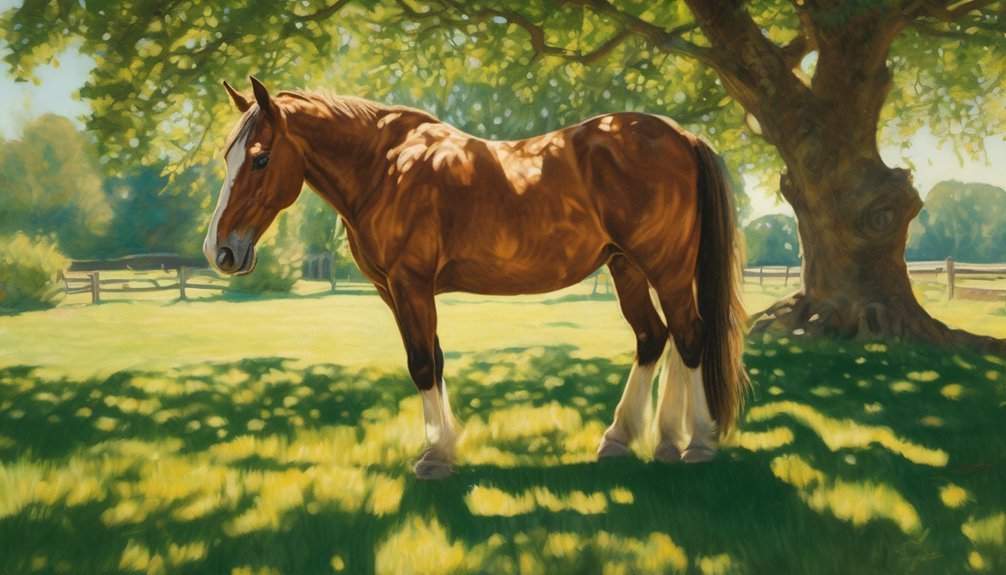
Imagine a horse with a stunning dappled coat, yet its luster fades despite regular grooming. This scenario highlights the critical link between diet and coat quality. Nutritional deficiencies can dull even the most vibrant dapples, impacting their visibility. To understand how specific nutrients contribute to coat health and what changes you might need to make, consider the essential components of a balanced diet for your horse.
Key Takeaways
- A balanced diet rich in high-quality proteins supports optimal coat health, enhancing the appearance of dapples in horses.
- Nutrients like vitamins A, E, and biotin are essential for maintaining skin integrity and promoting a shiny, dappled coat.
- Deficiencies in zinc and omega-3 fatty acids can lead to dull coats and poor pigmentation, affecting dapple visibility.
- Seasonal diet adjustments can improve coat quality; warmer months may require different nutritional focuses to enhance dapple patterns.
- Healthy horses with proper nutrition are more likely to exhibit vibrant dapples, reflecting their overall health and well-being.
Understanding Dapples: What They Are and Why They Matter

Dapples are those distinctive, mottled patterns often seen on the coats of horses, and they hold significant importance in equine health and genetics.
Understanding dapple genetics can deepen your appreciation for these unique coat patterns. Dapples typically appear as lighter or darker spots amidst a base coat color, often influenced by a horse's genetic makeup.
While certain breeds are more prone to exhibit dapples, their presence can also indicate optimal health and nutrition. A well-balanced diet, rich in vitamins and minerals, can enhance coat appearance, leading to more vibrant dapples.
The Role of Genetics in Coat Appearance
Genetics plays a pivotal role in determining a horse's coat appearance, including the presence and pattern of dapples. Each horse inherits specific genetic markers that influence their coat color and texture, contributing to unique dapple patterns. Breed variations also significantly impact these traits, as some breeds are predisposed to more prominent dapples than others.
Here's a quick look at how genetics and breed influence coat appearance:
| Factor | Impact on Dapples |
|---|---|
| Genetic Markers | Define color and dapple patterns |
| Breed Variations | Influence dapple prominence and style |
Understanding these genetic aspects can help you appreciate the beauty of your horse's coat and its distinct dapples.
Essential Nutrients for Healthy Coat Development

To achieve a vibrant and healthy coat, it's essential to provide your horse with the right nutrients, as deficiencies can lead to dullness and poor coat quality.
Focus on high-quality protein sources, like alfalfa or soy, which help build the structure of the coat. A balanced intake of vitamins, particularly A, E, and biotin, is crucial for optimal coat health.
Vitamin A supports skin integrity, while vitamin E acts as an antioxidant, promoting shine. Biotin plays a vital role in keratin production, essential for strong hair.
Ensure your horse's diet maintains a proper vitamin balance, as this promotes not only a glowing coat but also overall well-being. Regularly assess and adjust their feed to meet these essential nutrient needs.
The Impact of Seasonal Changes on Dapple Formation
As the seasons shift, the effects on your horse's coat can significantly influence dapple formation.
Seasonal shedding plays a crucial role here. During warmer months, your horse may shed its winter coat, revealing a fresher, vibrant layer underneath that enhances dapple visibility. Conversely, in colder months, the thicker coat can obscure those beautiful patterns.
Climate effects also matter; humidity and sunlight exposure impact how your horse's coat reflects light, affecting dapple prominence. If the climate is particularly harsh, it may lead to uneven shedding, further complicating dapple formation.
Common Dietary Deficiencies and Their Effects on Coat Health

While you may not immediately associate diet with coat quality, common nutritional deficiencies can have a profound impact on your horse's coat health, including the formation of dapples.
Key nutrients like biotin, zinc, and omega-3 fatty acids play essential roles in nutrient absorption and coat pigmentation. Without adequate levels, you might notice a dull coat or uneven pigmentation, signaling a deeper issue.
For example, a deficiency in zinc can hinder the formation of healthy hair follicles, leading to a lackluster appearance.
Understanding these deficiencies empowers you to make informed dietary choices that promote vibrant coat health. By addressing these nutritional gaps, you're not just enhancing your horse's appearance—you're supporting their overall well-being and vitality.
Supplements That Promote a Shiny, Dappled Coat
Incorporating the right supplements into your horse's diet can significantly enhance coat quality, particularly in achieving that sought-after shiny, dappled appearance.
When you choose effective coat supplements and shine enhancers, you're investing in your horse's overall health and beauty.
Here's a list of four supplements that can make a difference:
- Omega-3 Fatty Acids – These promote a healthy coat and reduce inflammation.
- Biotin – Essential for strong, resilient hair growth.
- Zinc – Supports skin health and enhances coat color.
- Flaxseed Oil – Adds moisture and shine, making the coat glisten.
Feeding Strategies for Optimal Coat Condition

To achieve optimal coat condition, it's crucial to focus on your horse's feeding strategies, as the right nutrients can directly influence coat health.
Incorporating dietary fats into your horse's diet is essential; they provide the necessary building blocks for a shiny coat. Omega-3 and omega-6 fatty acids, found in fish oil and flaxseed, promote coat hydration and enhance overall luster.
Additionally, ensure your horse receives adequate vitamins and minerals, particularly biotin and zinc, which support skin health. Regularly assess your horse's weight and adjust feed accordingly, as a well-nourished horse is more likely to exhibit a healthy coat.
Monitoring and Adjusting Diet for Coat Health Throughout the Year
Throughout the year, monitoring and adjusting your horse's diet is essential for maintaining optimal coat health.
Seasonal feeding plays a crucial role in ensuring your horse's coat remains vibrant and healthy. Here are four key dietary adjustments to consider:
- Spring: Increase omega-3 fatty acids for a shiny coat as your horse sheds winter fur.
- Summer: Provide hydration-focused feeds to combat heat and maintain skin health.
- Fall: Introduce antioxidants to help with transitioning coats and boost immunity.
- Winter: Add extra calories to support warmth and enhance coat condition.
Frequently Asked Questions
Can Certain Foods Cause Dapple Patterns to Fade?
Certain foods can indeed influence dapple fading. Nutritional elements, like antioxidants and fatty acids, play a role in maintaining coat health. By adjusting your diet, you might enhance the vibrancy and longevity of these patterns.
Do Different Breeds Have Specific Dietary Needs for Dapples?
You might think all horses have the same dietary needs, but different breeds require specific nutrients for optimal coat health. Tailoring their diet can enhance dapples, ensuring vibrant patterns and overall well-being.
Is It Possible to Enhance Dapples Through Diet Alone?
You can enhance dapples through diet, especially with specific dietary supplements and improved coat nutrition. While genetics play a role, proper nutrition can contribute to a healthier, more vibrant coat, potentially accentuating dapple patterns.
How Do Environmental Factors Influence Dapple Appearance?
Environmental exposure, like sunlight and humidity, can significantly affect dapple appearance. While genetics play a crucial role in determining patterns, these external factors can enhance or diminish their visibility, creating a unique display for each horse.
Can Hydration Levels Affect Dapple Formation in Coats?
Absolutely, hydration levels significantly impact coat health. When you ensure your horse stays hydrated, you promote better skin and coat condition, which can enhance the visibility and vibrancy of dapples in their coat.
Conclusion
In conclusion, your horse's diet plays a crucial role in displaying those beautiful dapples. By ensuring they receive essential nutrients and addressing any deficiencies, you can enhance their coat quality. Remember, genetics may set the stage, but nutrition takes the spotlight. As seasons change, stay proactive in adjusting their diet to maintain a vibrant, healthy coat. With the right feeding strategies, you'll not only promote dapples but also support overall well-being, making your horse shine all year round.





